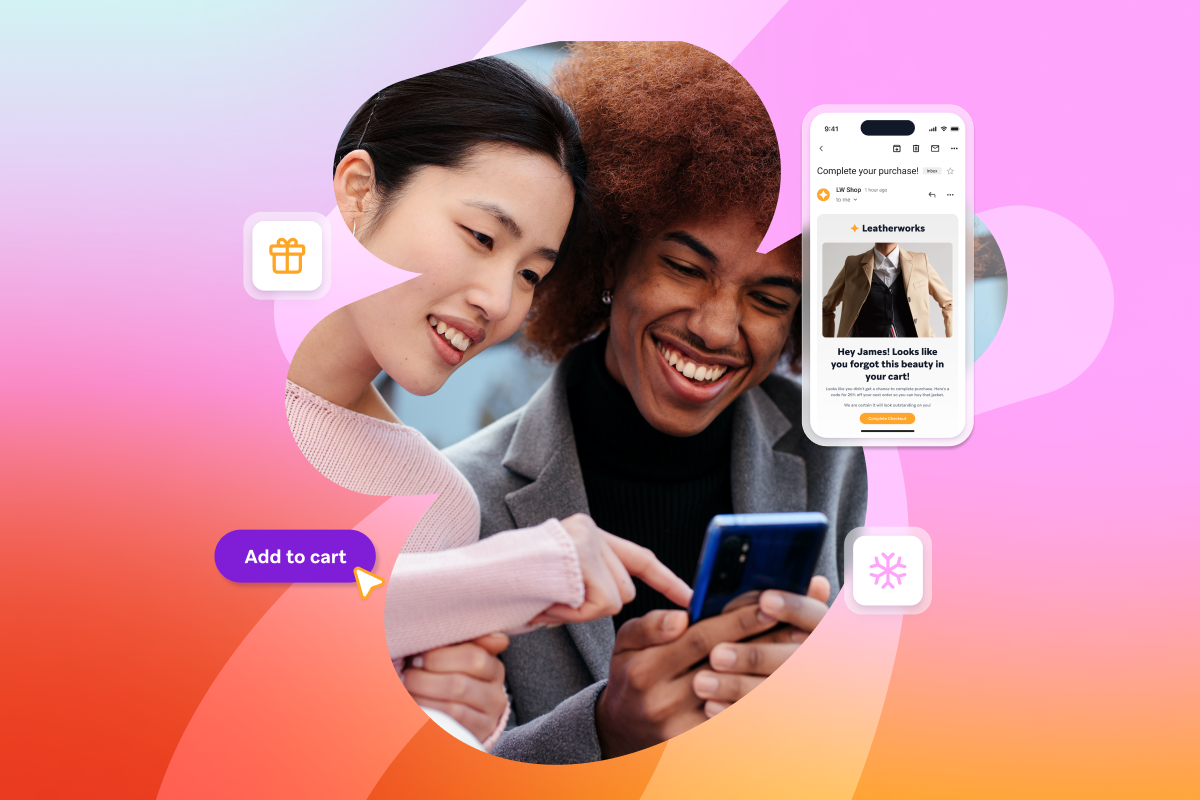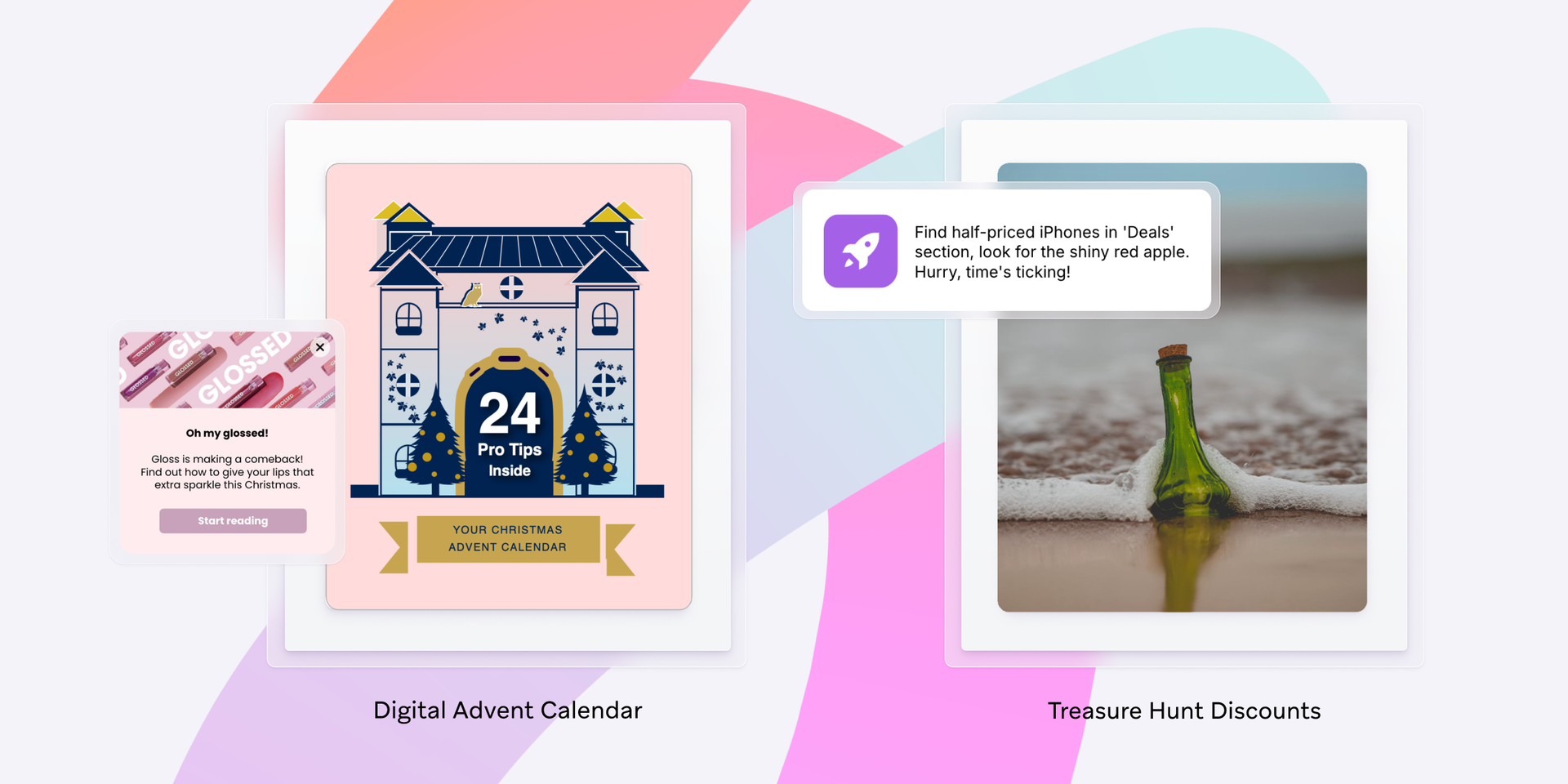Holiday Email Deliverability: Tips and Tricks from Braze Experts
Published on November 21, 2024/Last edited on November 21, 2024/16 min read


Team Braze
Email marketers have a tough job year-round, but the holidays dial up the difficulty level by increasing competition for that coveted spot in the inbox. Combined with pressure to reach those Q4 goals with tight marketing budgets, the idea of sending even more mail can feel daunting.
Luckily, Braze is here to help. Alison Gootee, Compliance & Deliverability Enablement Principal II at Braze and Lindsey Silverman, Senior Creative Strategist from the 427° Innovation Lab at Braze, dropped by our Braze Bonfire community to answer questions and share insights on how to navigate the complexities of holiday email deliverability.
Keep reading for Alison and Lindsey’s pointers for making the most out of Black Friday, Cyber Monday, and beyond.
How do I increase volume safely around the holidays when everyone else is also increasing volume?
Alison: Any time you plan on increasing the amount of mail you send, it’s critical to keep the subscriber experience in mind. Starting during the Black Friday/Cyber Monday (BFCM) season, more email is being sent (and filtered by) mailbox providers, and everybody’s inboxes are stuffed to the brim. Some brands begin to send multiple emails a day, hoping to catch recipients at the exact right time and snag a conversion.
On the one hand, more mail could mean more opportunities to make sales. But on the other hand, it also means that there are more messages that may linger in the inbox unread, which is both bad for sender reputation and decreases the ROI of your marketing efforts.
If you’ll be sending more messages to folks who are already actively engaging with your email content, remember that engagement doesn’t last forever. If people feel overwhelmed by the additional outreach efforts, they could unsubscribe or report you as spam, which means they’ll be lost forever (or until they sign up again). Rather than risk damaging your reputation with subscribers or their mailbox providers, consider leveraging a preference center that allows subscribers to pause or reduce the emails they receive from you. You can send an email that proactively notifies users that your holiday sending will be more frequent, and ask if they want to update their preferences to either stop mail for a specified period of time, or give the option of downgrading to weekly or monthly messages.
You can also highlight the preference center in the body or footer of your campaign with a call-to-action that says something like: “Too much holiday mail? We get it! Click here to manage your subscription,” and directs users to the preference center without explicitly calling out that you’ll be ramping up sends.
If you’ll be including lapsed or less-engaged audience members in your holiday sends, do so gradually and assess how they impact your overall results. Users with no history, or engagement older than 12 months, could be spam traps or otherwise dangerous data, so pay close attention to bounces, complaints, and open rates. Sender reputation can rapidly decline if recipients don’t respond positively to your overtures, and you don’t want to lose the inbox placement you worked hard all year to earn!
As a note, if you’re tempted to make it more difficult to unsubscribe—don’t! Unsubscribes are reputationally neutral but spam complaints are extremely damaging, and the “spam” button is in the same place for every message. Frustrated users can absolutely report mail as spam if that’s the easiest option, so highlight the ways that recipients can reduce mail safely.
Finally, consider leveraging alternate channels. Email is powerful, but it has some drawbacks, too. Email is not an instant messaging medium and has a reputation component, so deliveries can be delayed, blocked, or delivered to the spam folder. Alternate channels like mobile push and in-app messages can help you minimize risk before including lapsed users in your email audience. You can ask people to confirm their email address, update their subscription, or confirm their messaging preferences, ensuring that your email reputation remains untarnished.
Any tips for keeping your customers informed about what to expect from your brand around the holidays?
Alison: I am a huge proponent of honesty in email marketing. Sender reputation is essentially a measure of consumer trust, so I think it’s important to be straightforward whenever possible. There is often a lot of mystique around holiday sales; brands want to drum up interest and keep shoppers returning regularly to make repeat purchases, but consumers want to finish shopping, relax, and enjoy their holiday feeling secure in the knowledge that they got the absolute best deal possible. Since each party wants what the other has, I think clear expectations ensure everyone wins.
Rather than waiting to announce each day’s deal, why not send out a schedule ahead of time? Let customers know about incentives before Black Friday so they can plan accordingly. That way, they get exactly what’s on their list (and maybe a little extra!), and you don’t have to deal with a customer service queue full of invective-laden price adjustment requests.
- If you send a BFCM schedule via email, you can even collect additional engagement info to help you build stronger segments for the duration of the holiday sending period. If someone opens or clicks the announcement, you know they’re going to be hyped up for sales when the day finally arrives.
- If they ignore it, maybe you don’t need to include them in your upcoming daily sends since their lack of interest can impact inbox placement for others.
- If you have access to other channels, you can even drive email engagement by directing users to check their inboxes for special subscriber-only deals.
How do we continue to maintain engagement when we’re sending so much around the holidays?
Alison: Engagement is really about delivering value to your users, so keep them at the forefront of your marketing plans. Of course, everyone understands intrinsically that there will be more email during the holiday season, but that’s not a justification to send low-effort messages. This is the time of year that you need to do whatever it takes to stand out, whether that’s eye-catching subject lines, entertaining content, or unbelievable discounts.
Email isn’t like a billboard or commercial—you’re not paying for airtime, you’re earning it through subscriber interaction. If your messages feel like the same ol’ ads you send all year, you’ll need to get more creative or suffer the spam folder consequences.
What are some ideas for creative campaigns around the holidays?
Lindsey: Our team did a “Holidays in July” festive Brazestorm to help our customers truly stand out this season. Keep in mind these ideas are even better with a cross-channel strategy.
Some of my favorite ideas were:
- Digital advent calendar: Capitalize on the gift-giving spirit during the holiday season. Create a digital advent calendar with messaging for 24 days in December. Each day reveals a new prize, discount, or gifting idea.
- Treasure hunt discounts: Send users on a search for special deals and discounts hidden throughout the website or app. Release clues through multiple channels; the more channels a customer opts in for, the more clues they get. Hurry, these deals are limited-quantity and limited-time!
- Personal shopper: This holiday season let’s use customer engagement messaging to help find the perfect gift for anyone on your list. We’ll ask a set of questions like the age of the person you’re shopping for, their preferences, and your price range, and from there, we’ll recommend the perfect gift that’s ready to add-to-cart.

Looking for more inspiration? Check out our Melting Points AI: New Flavors of Creativity guide.
Any tips for retaining the customers you just gained during the holiday season into the new year?
Lindsey: Don’t succumb to the holiday hangover—build a post-holiday plan that will extend the holiday cheer into the new year and beyond.
A few great campaign ideas to keep the momentum going:
- In-product surveys: Once the holiday season is over, some brands struggle to make meaningful improvements to the customer experience because they don’t have the data they need. The solution? Capture zero-party user insights with feedback surveys throughout the customer engagement lifecycle, especially during peak engagement months. These insights about what users are looking for can then feed into subsequent campaigns to deliver a tailored experience
- Prevent early-lapsing users: Reach out to your lapsing users via social or owned channels with tailored content that supports more frequent, deeper engagement.
- Kickstart your fresh start: Kickstart the New Year with a 7-day or 30-day challenge. There’s a cool opportunity to partner with a brand in another sector here, too. What if a marketplace teamed up with a wellness app? The two could guide users with tips on how to declutter a part of their home and list those items on the marketplace, coupled with a soothing meditation.
Want to learn more? Watch “Retain Your Holiday Customers Into the New Year and Beyond” or take the Braze Learning course ”Holiday Season Readiness with Email Deliverability.”
How do I reduce unsubscribes while I’m sending more during the holiday season?
Alison: If a recipient wants to stop receiving your emails, they have a few options. They can unsubscribe, they can click “spam”, or they can just do nothing. Unsubscribing is actually the least damaging option. By unsubscribing, they’re indicating that they believe you will honor their preferences. Mailbox providers don’t track unsubscribes, so there is no associated reputation damage when someone unsubscribes.
By contrast, spam complaints are the strongest negative signal that users can send, indicating that mail is unwanted or even malicious. If the recipient just does nothing and ignores your mail altogether, the mailbox provider will ultimately determine that the mail is unwanted, and though it may not be outright spam, it’s also not valuable enough to merit inbox placement and can safely be filtered to the spam folder. If enough users respond in that way, it will negatively impact your sender reputation and more mail will gradually be filtered as spam for larger portions of the audience.
To prevent users from unsubscribing or marking your emails as spam, focus on ensuring they want to keep receiving your messages.This is important year round, so don’t overlook your subscription process:
- It’s easy to collect addresses that are invalid, outdated, misspelled, or just low-quality, especially if subscription is incentivized (like with a coupon code) or required (like during registration).
- Ask people directly if they want to receive your emails, and make it easy for them to decline.
- Always perform double opt-in to ensure that addresses are valid and belong to the correct person. Implement a strong sunset policy to remove unengaged addresses from your mailable audience.
Around the holidays especially, content is crucial: You need to send mail that people actually enjoy receiving, whether it makes them smile or keeps them informed. This is also another great opportunity to highlight your preference center and give subscribers the option of reducing the amount or type of messaging they receive, or to even pause their subscription until after the holidays. Losing a subscriber isn’t ideal, but if someone is looking for a way to make the mail stop, unsubscribing is a much more appealing method than a spam complaint, and that “spam” button is very easy to find.
How should I incorporate BrazeAI™ into my holiday strategy?
Lindsey: As the holiday season approaches, incorporating BrazeAI™ into your strategy can significantly enhance your marketing efforts and drive better results. By leveraging AI throughout the holiday planning process, you can gain valuable insights from past campaigns, reduce the burden of menial tasks, and automate customer journeys for maximum engagement.
You can use AI at every phase of the holiday planning process, such as:
- AI data analysis: Learn from past holidays and spot trends early with Conversion Correlation which can identify what type of campaigns and behaviors lead to purchases
- AI to QA content: Avoid revenue-costing mistakes and lighten your workload leading into holiday with Content QA with AI. Let AI proofread your copy for errors, analyze the tone of your message and give suggestions on how to fix them.
- Automate the journey with AI: Automatically send customers down the best journey with Personalized Path. Create several paths for customer engagement with different triggers, messaging frequency, and messages. AI will handle the optimization.
Want more info? Check out Why AI is a Necessity for Retail Marketers.
How do you stand out during the holiday season in a crowded inbox?
Lindsey: Marketers have a tough job—standing out in their customers’ crowded inboxes. Here are some of our recommendations:
- Interactivity: During our Inbox Big Bets session at Forge 2024, we discussed the rise of interactivity in email. AMP for Email and partners like Movable Ink have revolutionized the way we interact with email by transforming static messages into dynamic experiences that resemble mini web pages within the inbox. Capabilities and features like product carousels, wishlists, and booking calendars can enhance engagement and bring joy to the email experience. Check out some of our favorite examples that bring this to life, such as the NBA and Instacart
- Do more with data: Treat subscribers like people, not static lists. Take a look into your data and target niche segments that are often overlooked. Consider eco-conscious customers who have visited your sustainability pages or users brought in through a refer-a-friend campaign. When you’re looking to provide customized experiences—and see stronger results—segmentation is one of the most effective ways to make that happen. Learn more from Too Good to Go.
- Subject lines: A compelling subject line can make all the difference. Check out 9 Best Practices for Email Subject Lines
- Take a cross-channel approach: Although we're talking a lot about email today, I'd also encourage you to think about a cross-channel strategy. There is the Intelligent Channel filter to send the message via the “best” channel for that user
If you haven’t prepped holiday campaigns yet, what are top three tips for getting something together now?
Lindsey: Take the time to define your key goals and objectives for this year's holiday marketing. What does success look like for your campaigns? What are your most important KPIs? Are you looking to drive awareness-related metrics or sales-related metrics, such as conversions?
Keep in mind the types of holiday customers. How can you personalize your experience for window shoppers, gift givers, VIP spenders, deal hunters, cart abandoners, and more? One way to do this is through personalization tools like segmentation, triggered campaigns, Liquid personalization, and dynamic content tools like Connected Content.
During the height of the shopping holidays, customers are abandoning the checkout flow and failing to complete transactions before they depart. Don't forget to send automated reminders to users who have not finished their transactions (and are opted-in to each channel) to bring them back into the checkout flow. Leverage A/B testing to determine the ideal timing windows for these messages and use personalized messages and special offers to nudge recipients to return and complete their purchases.
Alison: Make sure your data is in tip-top shape! I don’t typically recommend list cleaning services because your list is already “clean” as long as you regularly send to it, but if you have questions about any of your data, you can leverage a service like Kickbox to help you identify potentially problematic addresses. Be aware that a validation service cannot locate all spam traps and does not verify consent, so this isn’t a panacea. But when used as part of a root cause analysis, you can better determine which segments of your list are no longer viable and shore up any gaps in your current address acquisition/management processes.
Put your subscriber at the center of your plans. Who are you sending to? How can you help them? Are you sending to meet one of your own goals, or to help your customers reach theirs? While the holiday season can be full of positivity and warmth, it can also be stressful–consider what your products mean in the wider context of peoples’ lives before finalizing your plans. Some brands may benefit from sending twice daily emails and some may see more lift from simply being quiet. If you don’t know what subscribers want, ask them. Not only will this allow you to better serve your audience, but encouraging feedback like clicks and replies can help ensure continued inbox placement, providing a much-needed boost when sending to less-engaged addresses.
Replicate prior success. Recipients and mailbox providers both reward predictability, so what has worked well for you recently? What about last holiday season? If you can reuse content or copy previous plans, do that. This time of year is all about tradition and repetition; there’s nothing wrong with sending in ways that will be familiar to your audience.
What are some metrics to keep an eye on so that I can optimize future holiday campaigns?
Alison: Monitor your delivery, bounce, complaint, open, and click rates. Review the Braze Deliverability Center for Google Postmaster Tools and Microsoft SNDS data. Of course, revenue and conversions are top-of-mind, but if those sales came with a side of reputation damage, you may not realize the potential revenue loss until it’s too late.
What do I do if my holiday sends aren’t going well?
Alison: First, be sure you know how to recognize a marketing problem from a deliverability one, and respond accordingly. If mail is bouncing, then that’s probably a deliverability problem. If it’s delivering but folks aren’t converting, then that points more towards a marketing issue. If you have Braze Deliverability Services, you can reach out to your consultant to ask for help. If you don’t have services, the Support team may be able to troubleshoot.
If mail is being rejected, reported or filtered as spam, or just isn’t getting the response you wanted, don’t cry. Have some cookies and milk, and pull out your backup plan. It might be reducing your initial goals, switching gears and moving to another channel, or allowing more time to reach your targets. But before BFCM, you should have some idea of what you’ll do if things aren’t panning out the way you hoped. In most cases, you’ll need to pause sending while you recalibrate your content or segment conditions, and then resume sending at a lower volume while waiting for folks to engage, mitigating the damage.
If you’re blocked at a particular mailbox provider, you can attempt to reach those users via another channel in the meantime. Even if you don’t use push, in-app, or SMS, you may have a social media or community following happy to hear from you. If so, you can ask them to check their spam folders and move your mail to the inbox, or to reply to your messages to help demonstrate additional positive user feedback.
Most importantly, learn from the experience. Where did things go wrong, how can you incorporate that into next year’s plans, and what can you do to start earlier?
Related Tags
Releated Content
View the Blog
A day in the life of a data scientist on the BrazeAIᵀᴹ forward-deployed engineering team

McKay Jensen

The new inbox reality: How iOS changes are reshaping email marketing

Aparna Prasad

Experience optimization: Turning data insights into better journeys
